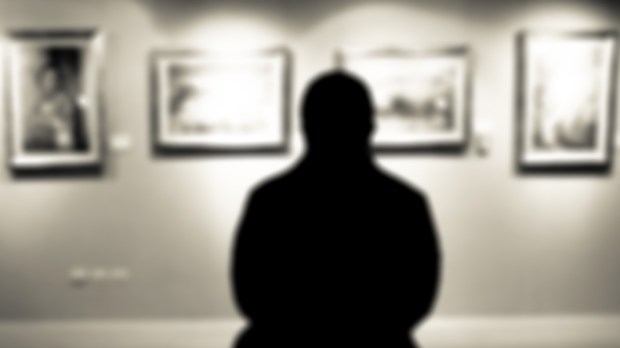Lenten Campaign 2025
This content is free of charge, as are all our articles.
Support us with a donation that is tax-deductible and enable us to continue to reach millions of readers.
Artistic works that have not seen the light of day in decades are getting a showing at the Vatican.
“Signs of the Sacred—The Imprints of the Real: Twentieth-century Graphic Arts in the Contemporary Art Collection of the Vatican Museums” is a collection of prints, drawings and photographs from the 19th to the 21st century donated by artists, benefactors and heirs to Pope Paul VI. The collection is accompanied by drawings, paintings and sculptures by important artists such as Edvard Munch, Paul Klee,, Max Ernst, Marc Chagall, Joan Miró, and Henri Matisse. It opened December 11 in Braccio di Carlo Magno, an exhibition hall just off of St. Peter’s Square, and will run through February 29.
The 150 or so works in the exhibition were executed on paper that is extremely delicate and fragile and have been protected in dark drawers for so long that Reuters dubbed them the “Vatican’s vampire prints.”
“They definitely don’t love the light,” Francesca Boschetti, the exhibition’s curator, told Reuters, explaining that they can be shown only for a brief period to avoid fading and deterioration.
“Preserved in special conditions of light, humidity and temperature, the artworks on paper occupy a very limited space in the Vatican Museums, where only a few units are visible in rotation,” the Vatican Museums said in a press release.
The exhibition was conceived as a “circular narration,” the Museums said, which begins with the Creation of the World and ends with the creation of art. Some of the prints are accompanied by paintings and sculptures by the same artists or others that have “iconographic or chronological connections” with the prints.
Another thing about “Signs of the Sacred” is that many of the artists represented were not what one might normally think of as “religious” people. But they were attracted by spiritual themes, Reuters pointed out. An example would be Munch’s “Old Man Praying,” a 1902 woodcut on rice paper.
“In times of personal travails or great social upheaval such as during and between the two world wars, even artists who did not normally do religious themes turned to them as a metaphor for suffering and violence,” Boschetti told the wire service.
Said Barbara Jatta, director of the Vatican Museums:
Both the catalogue and the exhibition itself have been sub-divided into four principal sections, each one of which covers different aspects of the representation of the ‘Signs of the Sacred’ and the ‘Imprints of Real.’ In the first section, The Sentiments of the Sacred and the Human, works dealing with subjects from both the Old and New Testaments are included. But above all the subjects of the maternity of the Virgin, prayer and martyrdom, up until the war and the Apocalypse. In this section one is struck particularly by the subject of maternity … with important works by Matisse, Venturino Venturi, Emilio Greco, and a splendid Thayaht. The subject of martyrdom is also rendered very effectively by the selection of woodcuts by Lorenzo Viani, with very real themes, such as shipwreck, offering and waiting. Echoes of war figure in different ways in the works of Rouault, Chagall, Manzù, Messina, and also Marino Marini and Guido Strazza, in which Christological martyrdom is united with the horrors of war.”
The section includes a stereoscopic Crucifixion by Salvador Dalí—two lithographs designed to be observed with a special viewer that makes the image three-dimensional.
“The section focuses on the universality and actuality that some themes bring with them,” says the press release. “Georges Rouault, Marc Chagall, Marino Marini, Renato Guttuso, Guido Strazza in the years of the two world wars, use sacred iconographies to give voice and face to the injustices and sufferings of war.”
“In the second section, dedicated to ‘The Imprints of the Real,’ attention is turned to still life, objects in daily use, landscapes created by working and urban architecture, trees as if they were people, in the search for the mysterious link between the daily round and transcendence,” Jatta continued. “Here are works by De Carolis, Boccioni, Morandi, Luigi Bartolini, the great masters of the 1900s. In this section the wonderful trees of Carlo Mattioli are also placed, and sacred urban architecture, with prints by Anselmo Bucci, Nolde, Delaunay, Feininger, Klee, Vlaminck, Kirchner and many others.
The third section, “Origin of an Idea,” offers insight into the the creative process, when the idea of the artist begins to take shape and the creation of a work begins. Papers, plaster and bronze sketches tell the evolution and the stages of the creative path of artists such as Mario Sironi and Umberto Boccioni, Giacomo Manzù, Pericle Fazzini and Cecco Bonanotte and Santiago Calatrava.
Jatta continued:
The final selection, ‘Sign and Color,’ analyzes works of which the majority are not iconic, rather abstract, investigating the links between the use of the foundational expressive means of artistic language, which are sign and color, and their capacity to communicate spirituality and a sense of the sacred. Braque, Hartung, Lucio Fontana, Melotti, Mario Ceroli, Dorazio, Scialoja, up until Almagno, a wide panorama which covers the whole arc of the last century and continues until today.
The 20th-century graphic art collection was founded in 1973, in parallel with the creation of a section dedicated to 20th-century art. The latter was desired and inaugurated by Pope Paul VI, who called on the world of art to reconnect the historical link between the Church and contemporary culture. Many artists, heirs and patrons personally gave the pope prints and drawings.

